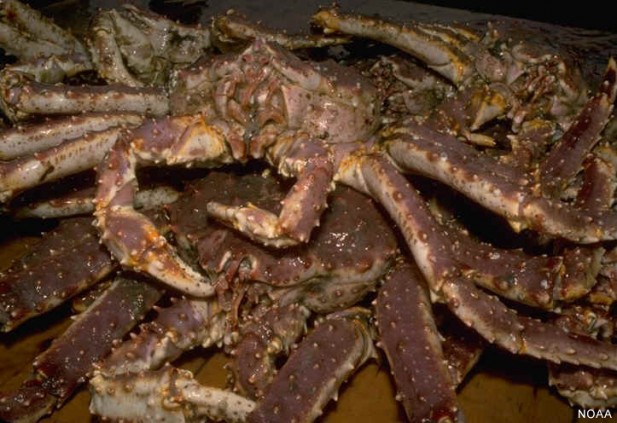
© NOAA
Global warming is the most likely cause of a growing number of king crabs that have been marching along the sea floor toward West Antarctica, according to a report by biologists on Wednesday.
The intruder,
'Neolithodes yaldwyni Ahyong and Dawson', a bright-red deep-sea predator that had previously been spotted only in the Ross Sea, on the other side of West Antarctica, is now living and reproducing in abundance on the western edge of the icy continent.
Writing in the journal
Proceedings B, scientists said the crabs are currently thriving in the Palmer Deep, a basin cut in the continental shelf. They believe the crabs were washed in during an upsurge of warmer water.
The crabs are ravenous predators on the sea floor and could likely change the ecosystem profoundly if they spread further, researchers warn. The crab is known as an "ecosystem engineer" because it digs into the sea floor to feast on worms and other tiny animals, an activity that can have repercussions across the marine food web if these crabs continue to multiply and spread out.
A team of scientists, led by Laura Grange of the University of Hawaii at Manoa, lowered a remotely operated vehicle (ROV), named the Genesis, into the Palmer Deep in March of last year as part of a long-term probe into biodiversity in the waters off Antarctica.
The team, who were looking to see what types of life existed in the cold ocean waters of the Palmer Deep, were surprised to find so many crabs in that area. Judging by the density of the crabs and their tracks, the team estimated there may be 1.5 million crabs in the basin.
The ROV trailed over 1.2 miles and spotted 42 crabs, all at depths lower than 2,760 feet, where the water was a balmy 34.5 degrees Fahrenheit. The seas actually get warmer the further you descend. It is believed these crabs cannot tolerate water colder than that temperature. The team estimated the crabs are confined to an area 9 miles long by 5 miles wide. The researchers believe the crabs have only been in the area for 30 to 40 years. Before that, the water would have been too cold even at the bottom of the Palmer Deep.
"Our best guess is there was an event, or maybe more than one, where warmer water flushed up across the shelf and carried some of the larvae into the basin," said Craig Smith from the University of Hawaii, a co-leader of the project.
The crabs cannot survive on the continental shelf, which is at a depth of 1,640 feet, but the team believes that could change.
"If you look at the rate at which the seas are warming, (the continental shelf) should be above 1.4C (34.5F) within a couple of decades, so the crabs are likely then to come into shallower waters," Smith told BBC News.
The upper limit of the crab-dwelling zone also marks the line between abundant seabed life above and depleted life below. "Above the crab zone, the abundance and diversity of plants and animals was high, with echinoderms including brittlestars, sea lilies and sea cucumbers," said Smith.
"We found none of them in the crab zone itself, and when we went 50-100m above we found very few - so we think the crabs are venturing up into shallow waters to feed," he said. "We would expect (local) extinctions in some of these organisms."
With a shell measuring roughly 4 inches across and a leg span of up to 39 inches, these animals are generally considered the top predators in the seafloor ecosystem. And images from the ROV gave researchers a glimpse of the kind of damage caused by these foraging crustaceans.
The team found the crabs had dug gashes up to a foot into the soft ocean floor and thrown up lumps of sediment. The evidence from seafloor sediment is that no lithodid (crushing) crabs have inhabited the cold shallow waters of the West Antarctic peninsula for 14 million years.
The team also retrieved a female crab and found it to be carrying mature eggs and larvae.
Previous research has already named the peninsula as one of the most vulnerable regions in the world for global warming. The waters of its continental shelf are warming at the rate of 0.14F per decade.
"If
N. yaldwyni is currently limited by cold temperatures, it could spread up onto the shelf within one to two decades," the team warns.
King crabs comprise a group of about 120 species, and one member, the red king crab is already posing an ecological impact in Norwegian waters following its slow spread from Russia.
However, king crabs in the northern hemisphere are also commercially important, with Norwegian fishermen alone bringing in thousands of the crustaceans each year.
Fishing crabs for profit in the Antarctic is not permitted. But in time, fishing as a means to control them could be allowed if their ecological impacts become too severe, said Smith.
Maybe we should be following them to safer grounds. maybe they know something that we don't!